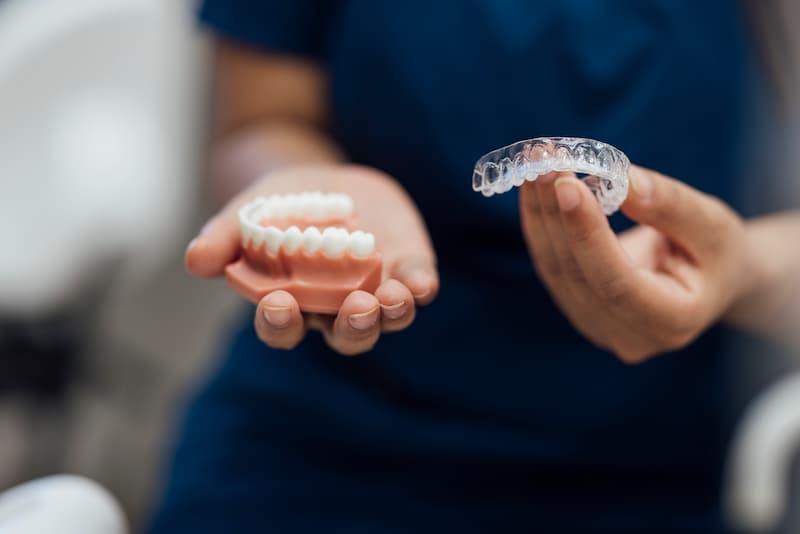Our 3 Locations
Are Clear Aligners Better Than Braces?

When it comes to straightening your teeth, you have more choices than you might think. While traditional braces are often the first option that comes to mind, clear aligners may be the better choice for you. Both options promise a bright, aligned smile, but each has unique features, benefits, and drawbacks. At Peak Family Dental Care, we can help you decide which is best for you. Let’s take a look at clear aligners vs. braces and how our Flagstaff, AZ patients can improve their smiles.
Differences Between Clear Aligners and Braces
Before we can decide which is better, we need to understand the difference between clear aligners and braces. Here’s what you need to know about each option:
Clear Aligners
Clear aligners are custom-made, transparent trays that fit snugly over your teeth. These trays gradually shift your teeth into the desired position by applying gentle, consistent pressure. You’ll receive a series of aligners throughout the treatment process, each one slightly adjusted to continue tooth movement. We use Spark Aligners, which are virtually invisible and removable for easy eating, drinking, brushing, and flossing.
Metal Braces
Traditional braces consist of metal brackets glued to your teeth and connected by wires and bands. Orthodontists adjust the tension of the wires periodically to gradually shift your teeth into place. Braces are fixed appliances, meaning they remain in place for the entire duration of the treatment. While they’re sometimes less comfortable than clear aligners, metal braces are usually the better choice for patients with complex orthodontic needs.
Comparing Metal Braces Vs. Clear Aligners
Next, let’s take a deeper look at the distinctions between clear aligners and braces. These differences extend beyond their simple definitions and will influence which option is best for you. Here are some key areas to evaluate:
Effectiveness in Treating Misalignment
Clear aligners are highly effective for minor to moderate alignment issues, such as overbites, crowded teeth, and gaps between teeth. However, they aren’t always as effective for severe malocclusions or teeth requiring significant movement. Metal braces may be your best bet to fix a severe underbite, rotated teeth, or major spacing issues.
Aesthetic Appeal
Clear aligners win the aesthetic category hands-down. Their transparent design makes them almost invisible, a huge advantage for adults or teens who prefer a subtle orthodontic treatment. While some metal braces are less conspicuous than they used to be, they are still more noticeable than clear aligners. Traditional metal braces may be more suitable for younger patients who aren’t as concerned about visibility.
Comfort and Convenience
Clear aligners are made from smooth plastic, meaning no sharp edges to irritate your gums or cheeks. However, switching to a new set of aligners every week or two may cause temporary discomfort as your teeth adjust. Although aligners are removable to make eating easier, you’ll need discipline to wear them for the required 20 to 22 hours a day.
Braces, on the other hand, may cause more irritation due to their metal brackets and wires. Adjustments can also lead to soreness for a few days. They require meticulous cleaning and dietary restrictions to avoid damaging the brackets or wires. But because braces are fixed appliances, you don’t have to worry about forgetting to wear them.
Cost Comparison
Are clear aligners cheaper than braces? The answer to this common question is that it depends. The pricing for clear aligners can range from $3,000 to $8,000, depending on the complexity of your case and the brand of aligners. Metal braces are sometimes more affordable but may end up costing the same as clear aligners. A general range for traditional braces comes in at $2,500 to $8,000.
Maintenance and Oral Hygiene
With clear aligners, oral hygiene is a breeze. Simply remove the trays to brush and floss your teeth. Don’t forget that the aligners themselves need to be cleaned daily to prevent plaque buildup. Unlike clear aligners, braces take some extra work. Brushing and flossing around the brackets and wires can be tricky, increasing the risk of plaque and food buildup. Many orthodontists recommend special tools like floss threaders or water flossers.
Treatment Duration
Clear aligner treatments typically last between six months and two years, depending on the severity of the case. Patients who don’t adhere to the proper guidelines might need to wear clear aligners for even longer. Traditional braces often take a bit longer to work. Patients can expect between one and three years for a complete treatment, but this can vary depending on the complexity of their case.
Making the Best Choice for You
When choosing between clear aligners and braces, there is no one-size-fits-all answer. Your lifestyle, budget, aesthetic concerns, and orthodontic needs all play a role in making the right decision. Fortunately, our dentists are here to help you make the right choice. We specialize in orthodontic aligners and will ensure you get all the benefits of this treatment. Request an appointment today to learn more about orthodontics in Flagstaff, Cottonwood, and Sedona.
